|
Manitou Pontoon Boats |
 |
Manitou raised expectations through a
revolutionary redesign of the traditional
pontoon hull and in the process raised the heart
rate of the entire boating community. Better
hole shots, quicker to plane, higher top end
speeds, unrivaled handling and increased
stability in rough water are all hallmarks of
the Manitou performance-minded pontoon boat.
Manitou challenges you to raise your own
expectations (and heart rate) by test driving
one of their pontoon boats. We're confident
you'll agree that a Manitou pontoon boat is all
the boat you'll ever need.
|
|
Traditional Hull
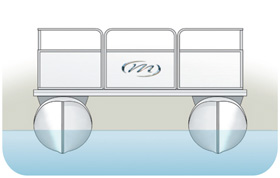
|
VP

|
SHP
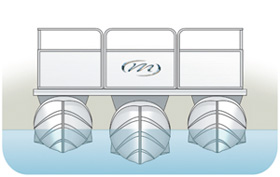
|
|
Our most economical hull design. Ideal for slower cruising
but stable enough for a full load of passengers. Although
typically paired with smaller engines, the twin hull design
can still pull tubers and lighter skiers but with less
acceleration and more limited turning ability.
|
The new VP offers boaters a much wider
range of mid-level performance. The VP
will pop-out of the water easier and
plane at speeds into the upper 30s with
a maximum 150 HP. The VP uses positive
angle lifting strakes on the center tube
to provide a much smoother, higher ride
on rougher water.
|
The SHP is a trademarked evolution of
the triple tube. The SHP hull is a
combination of a larger and deeper
center tube, positive angle lifting
strakes, and our signature Barracuda
nosecones. Hallmarks of this hull are
improved efficiency, maneuverability,
and ride.
|
|
 |
|
Newton's
Law states that every object continues in its state of rest,
or of motion, until external forces are exerted upon it.
Left to themselves, boats do not accelerate, decelerate or
change direction. While some pontoon manufacturers focus on
static influences like buoyancy and stability in calm water,
we choose to focus our efforts on the dynamics that
determine performance while in motion. |
|
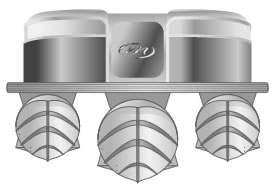 |
Center
Tube Design
The exact
depth of our center tube with positive angle lifting strakes
provides stability, razor sharp turning and the superior
ride normally associated with V-hulls. The precise degree of
deadrise is the key that unlocks a hull's performance
characteristics. Too much or too little dead rise, can
detrimentally affect ride quality, stability, acceleration,
speed and handling. At ManitouŽ, our engineers have spent
years testing pontoon hull configurations resulting in our
industry leading V-ToonŽ Technology. |
Lifting
Strake Design
Much of the
critical engineering in a performance triple tube hull is in
the balance of precise hull geometry and strategically
designed and placed lifting strakes. Like reverse angle
chines on a monohull, negative angle lifting strakes can
increase lift but have negative impacts on ride quality by
increasing slamming loads. Conversely, positive angle
lifting strakes provide the needed planing surface, deliver
a smooth ride and enhance the nimble reflexes of a V-Toon.
Inferring that strakes are detrimental to performance when
placed on the outside of the lateral tubes may be true on
our competitors boats, which are less agile and less
predictable at higher speeds, but not ours. When you need to
get back to a downed skier, want to get to a fishing hole
first, or need to outrun the weather, you need the speed and
agility only found on a V-Toon hull. Don't fall for the
smoke and mirrors of false claims, demand V-Toon Technology
with Positive Angle Lifting Strakes. |
|
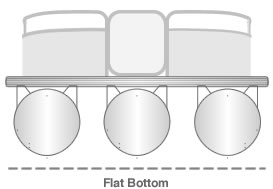 |
Theirs
Simply
adding a center tube will increase stability and buoyancy
but will not necessarily improve handling. By widening the
center tube and adding strakes, our competitors have been
successful at getting their boats to heel (bank) at slow
speeds, but these boats handle erratically at planing
speeds. Without deadrise, the lateral forces exerted on a
hull, during a turn, overcomes the boats ability to bank.
This causes uncontrollable heeling to the outside. At
ManitouŽ we believe your family deserves safe, confidence
inspiring, predictable handling and we deliver nothing less. |
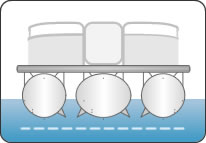
Elliptical Pontoon
|
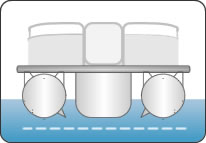
U-Shaped Pontoon
|
Almost every pontoon company claims that their
pontoon boats handle like a runabout or v-bottom
boat. But without a v-shaped hull, it is simply
impossible to have v-bottom handling. Passengers
that have ridden in flat bottom crafts or ones with
very little deadrise have experienced the bone
jarring ride and inadequate handling they produce.
Adding reverse chines or negative angled lifting
strakes only makes matters worse.
|
Ours
Manitou's
V-Toon hulls perform like hard chined, v-bottom mono-hulls.
Precise deadrise and strake combination allow our hulls to
heel into a turn like a race-car on a banked track providing
passengers with a more comfortable and safer ride. When
heeling, centrifugal forces are directed downward through
the hull, making it easier for passengers and gear to remain
in place. As speeds increase, the natural ability of a hull
to heel becomes increasingly important, not only for
comfort, but safety. |
|
 |
Deadrise
It is
deadrise that softens a boat's ride in rough water by
deflecting the energy created by wakes and wave action. The
angle of a hulls surface (deadrise) also contributes to a
boats ability to heel into a turn. Finding the ultimate
deadrise angle, that provides excellent ride qualities as
well as nimble handling, for triple tube pontoon hulls is
something that only the engineers at Manitou have mastered. |
Dynamic
Lift
All boats
at rest and prior to planing speed are supported by simple
buoyancy. As a boat accelerates,forces dynamically increase
between the planing surface of the hull and the water. With
adequate speed and enough planning surface, a boat goes from
its maximum displacement speed to planing. At planning
speeds static buoyancy contributes very little to boat
performance. So, why buy a boat that has an unnecessarily
large center tube that only contributes unneeded buoyancy
during displacement speeds or at rest? Hauling around the
added weight of an unnecessarily large center tube only
hampers a boats ability to perform above displacement
speeds. |
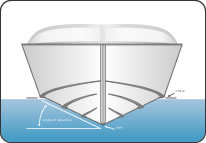
Deadrise
|
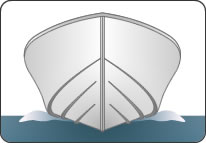
Dynamic Lift
|
Stability
at Speed
Performance
hulls respond positively and instantly to throttle and
steering input. Flat bottom style pontoon hulls, while
stable, are difficult to turn and react inadequately to
driver input during planing speeds. Our V-Toon Technology,
by virtue of deadrise and dynamic lift, provides a
confidence-inspiring platform when coupled with large
engines. Soft ride, great acceleration, higher top end
speeds, razor like handling and unwavering stability at
speed, that's V-Toon Technology. |
Bottom
Line
No one
builds flat bottom performance boats for a reason.
Maneuvering would be horrendous if not dangerous and the
slam loads would make the ride bone jarring. So why would
anyone, interested in performance and handling, buy a flat
bottom pontoon boat?
|













